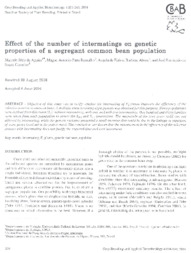Effect of the number of intermatings on genetic properties of a segregant common bean population.
Effect of the number of intermatings on genetic properties of a segregant common bean population.
Author(s): AGUIAR, M. S. de; RAMALHO, M. A. P.; ABREU, A. de F. B.; CARNEIRO, J. E. de S.
Summary: Objective of this study was to verify whether the intermating of F2 plants improves the efficiency of the selective process in common bean. A multiple cross involving eight parents was obtainedfor this purpose. Three populations were derived from this cross (So): without intermating, with one, and with two intermatings. One hundred and thirty families were taken from each population to assess the 5 0:2 and 5 0. 3 generations. The magnitude of the trait grain yield was not affected by intermating, while the genetic variance presented a small increase that could be due to the linkage in repulsion of some genes invclved in the trait control. The conclusion was drawn that the enhancement in the efficiency of the selective process with intermating does not justify the required time and cost investment.
Publication year: 2004
Types of publication: Journal article
Unit: Embrapa Rice & Beans
Observation
Some of Embrapa's publications are published as ePub files. To read them, use or download one of the following free software options to your computer or mobile device. Android: Google Play Books; IOS: iBooks; Windows and Linux: Calibre.
Access other publications
Access the Agricultural Research Database (BDPA) to consult Embrapa's full library collection and records.
Visit Embrapa Bookstore to purchase books and other publications sold by Embrapa.

